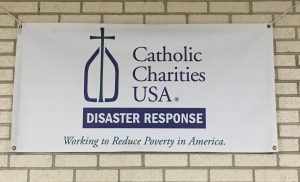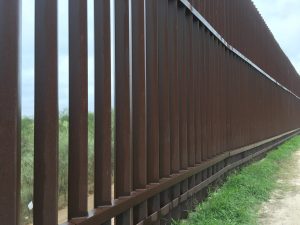Winter excavations have their own unique set of challenges. Today the high was in the 30s, it was very windy and rainy. It was the kind of weather that made me question whether we were actually in South Texas. We decided the risk of working wet in freezing temperatures was too great and decided to take the day off to go to McAllen. We loaded up the cars, got a bag full of Whataburger breakfast taquitos “to go” and started driving south on 281.

Our first stop was the Sacred Heart Church where the Humanitarian Respite Center is located. Sister Pam and Sister Norma talked about the function of the center: “The center provides a place for the countless men, women, children, and infant refugees to rest, have a warm meal, a shower, and change into clean clothing as well as receive medicine and other supplies, before continuing onto their journey.” We learned they were averaging 400 asylum seekers per day before Christmas and about 100 per day now in the New Year. We divided up into groups that sorted donations, made small bags of toiletries and baby supplies, helped in the kitchen, held babies and played with children so parents could shower, located new clothing for families and a variety of other tasks. The center runs solely on the kindness of volunteers and donations.

Once the morning’s group of families finished rotating through the center we drove to the border wall. This part of the wall is more of a fence made of iron beams repurposed from Vietnam era military materials. After approximately 6 minutes at the wall we were approached by a Border Patrol vehicle. At first we were nervous we would be asked to leave immediately, but instead the officer welcomed the opportunity to talk with us and answer questions. He told us stories of his experiences with patrolling the wall and the people he encountered.
We left McAllen and began our drive north on 281. We needed to go through the Falfurrias Border Patrol Station on our way home. While we had no trouble getting through the large three lane traffic checkpoint, the wait in line provided us a moment to reflect on the fact that this is the reason we see so many deaths in Brooks County. It is this checkpoint that migrants are attempting to circumvent as they enter the brush land that surrounds the station, resulting in many of them loosing their lives.

We ended the day at La Cope Ranch in Encino for dinner provided graciously by the Ed Rachel Foundation. Their mission statement is taken from the last will and testament of the Foundation’s benefactor: “I devise and bequeath the rest and residue of my estate of every kind and wheresoever situated real, personal and mixed, to such corporation to be used exclusively for the benefit of charitable, scientific, literary or educational purposes within the State of Texas“. The foundation has generously supported Texas State‘s work in migrant identification over the last few years. The meal was amazing and the representatives of the foundation were so nice and genuinely interested in the work we are doing towards migrant identification. The day off from digging allowed our muscles to rest and our minds to recharge. We are ready to jump back in to excavations in the morning.
~KEL



